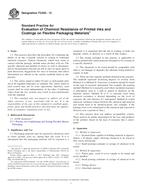We need your consent to use the individual data so that you can see information about your interests, among other things. Click "OK" to give your consent.
ASTM F2250-13
Standard Practice for Evaluation of Chemical Resistance of Printed Inks and Coatings on Flexible Packaging Materials
STANDARD published on 1.5.2013
The information about the standard:
Designation standards: ASTM F2250-13
Note: WITHDRAWN
Publication date standards: 1.5.2013
SKU: NS-53367
The number of pages: 3
Approximate weight : 9 g (0.02 lbs)
Country: American technical standard
Category: Technical standards ASTM
The category - similar standards:
Annotation of standard text ASTM F2250-13 :
Keywords:
alcohol resistance, chemical resistance, ICS Number Code 87.080 (Inks. Printing inks)
Additional information
| Significance and Use | ||
|
3.1 Packaging materials may be exposed to chemicals such as water, alcohol, acid, etc. during their life cycle. If it is anticipated that the packaging material will be exposed to a chemical, it is important that the ink or coating, or both, not degrade, soften, or dissolve as a result of that contact. 3.2 The testing included in this practice is applicable to surface printed and coated materials designed to be resistant to a specific chemical. 3.3 The chemicals to be tested should be compatible with (that is, not damage or degrade) the substrate being printed or coated, or both. 3.4 There are four separate methods detailed in this practice. The methods represent increasing degrees of severity from Method A to Method D. Selection of method should be based on the type of exposure anticipated. For example, the pouring method (Method A) is typically used where incidental exposure is anticipated, such as a spill or splash of chemical on the material surface. Method B or C is typically used when chemical resistance is desired depending on the level of exposure (B) and abrasion (C) anticipated. Method D would represent continual contact between the chemical and material and would need to be chemical-proof, (for example, if the package were to be submerged in the chemical and exposed to abrasion over a period of time.) 3.5 This practice does not address acceptability criteria. These need to be jointly determined by the user and producer of the product, based on the type of exposure that is anticipated. |
||
| 1. Scope | ||
|
1.1 This practice describes the procedure for evaluating the ability of an ink, overprint varnish or coating to withstand chemical exposure. Typical chemicals, which may come in contact with the package, include water, alcohol, acid, etc. The specific chemical and method of choice as well as determination of measurement outcome are left to users to agree upon in joint discussion. Suggestions for ways to measure and collect information are offered in the various methods listed in this practice. 1.2 The values stated in either SI units or inch-pound units are to be regarded separately as standard. The values stated in each system may not be exact equivalents; therefore, each system shall be used independently of the other. Combining values from the two systems may result in non-conformance with the standard. 1.3 This standard does not purport to address all of the safety concerns, if any, associated with its use. It is the responsibility of the user of this standard to establish appropriate safety and health practices and determine the applicability of regulatory limitations prior to use. |
||
| 2. Referenced Documents | ||
|
Similar standards:
Historical
1.6.2011
Historical
1.6.2012
Historical
1.6.2013
Historical
1.6.2010
Historical
1.6.2012
Historical
1.6.2011
We recommend:
Technical standards updating
Do you want to make sure you use only the valid technical standards?
We can offer you a solution which will provide you a monthly overview concerning the updating of standards which you use.
Would you like to know more? Look at this page.



 ASTM D6688-11
ASTM D6688-11 ASTM D6846-02(2012)..
ASTM D6846-02(2012).. ASTM D6989-03(2013)..
ASTM D6989-03(2013).. ASTM D7188-05(2010)..
ASTM D7188-05(2010).. ASTM D7189-12
ASTM D7189-12 ASTM D7244-06a(2011)..
ASTM D7244-06a(2011)..
 Cookies
Cookies
